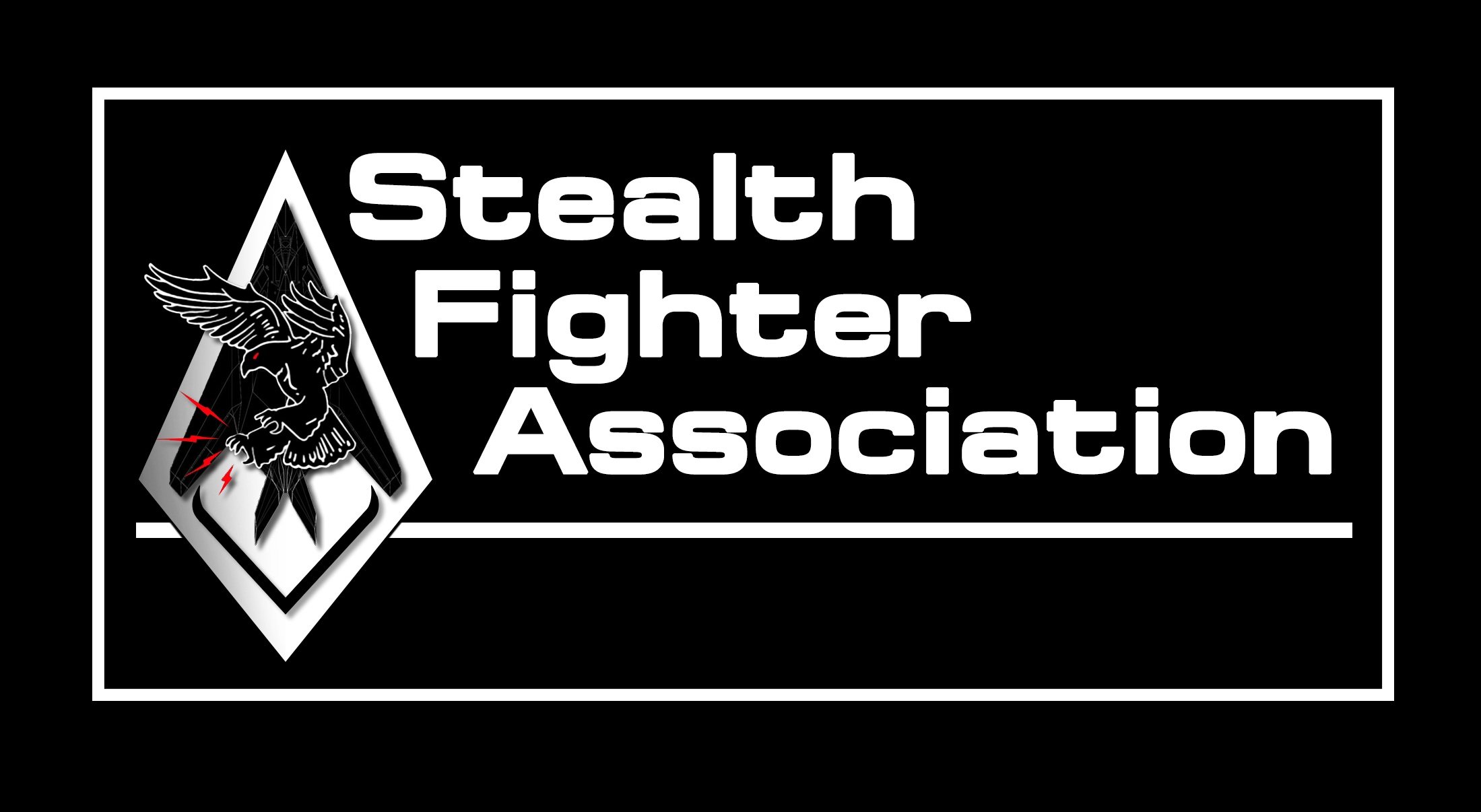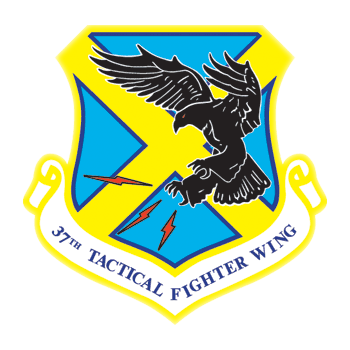F-117 Organizations
Baja Scorpions
Emblem Significance
The Baja Scorpions patch was designed by Dick Meathrell and the late Dick Abrams. The name Baja Scorpions was conceived by Dick Meathrell, F-117 Flight Test Administrator, very early in the F-117 Flight Test Program, the result of an assignment to Dick by Flight Test Director, Keith Beswick. Keith had suggested an organization patch featuring a graduating senior's cap with a performance chart's jagged trend line to designate the program's code name, Senior Trend. After enduring much derision for his suggestion, Keith assigned Dick Meathrell the task. The F-117 Flight Test group was located in a complex at the south end of the test site.
To the rest of the personnel at the test site, they were known as the South Enders. From this was derived Baja, the Spanish word (loosely translated) for south. A rattlesnake came to mind when Dick was searching for a mascot. However, this was decided against because, unlike the radar-eluding F-117, the rattlesnake provides ample warning prior to striking. Then, one day, a scorpion was found in one of the hangars and captured. Because scorpions strike without warning, this potentially dangerous creature turned out to be a blessing by providing a symbolic mascot.
4450th Tactical Group
Emblem Significance
The 4450th's emblem is a Nighthawk in the attack position on a black background, symbolizing night operations. The bird is white, with the bird's eye and lightning bolts embroidered in red to add color.
37th Tactical Fighter Wing
Emblem Significance
A black Nighthawk in flight, poised in an attack position, refers to the Wing's ability with the F-117 Stealth Fighter to meet worldwide commitments with swiftness, strength, and sagacity. The white highlights around the hawk suggest the aircraft's spectral nature, while the white-outlined feathers allude to the F-117's mastery over a silent approach to its intended target. The background element, a cross of Air Force yellow, notes the 37th's heritage as the 'Defender of the Crossroads.' The ultramarine blue border between the oriental blue areas and the arms of the yellow cross depicts the 37th's membership in the Air Force and Tactical Air Command community. Moreover, the transition from oriental blue to ultramarine blue insinuates the Air Force's new capability to operate effectively in both day and evening skies. The three red lightning bolts surging from the hawk's claws imply that three operational squadrons are ready to carry out the 37th's mission with strength and zeal for the Air Force. The hawk's red eye denotes its ability to find and track its prey.
49th Fighter Wing
49th Fighter Wing
The 49th Fighter Wing supports national security objectives with mission-ready F-117A stealth fighters, an Air Transportable Clinic and Bare Base assets. The wing deploys worldwide to support peacetime and wartime contingencies, trains USAF aircrews in F-117A and T-38A and allied aircrews in F-4F Fighter Transition and Weapons Instructor Courses, and provides support to over 18,000 personnel to include German Air Force Tornado operations.
Emblem Significance
Blue and yellow are the Air Force colors. Blue alludes to the sky, the primary theater of Air Force operations. Yellow refers to the sun and the excellence required of Air Force personnel. The Light and Dark Blue colors signify the unit’s day and night defense of freedom. The winged knight’s helmet reflects the Wing’s long and distinguished history of military engagements. The stars represent the constellation “Southern Cross” and denote the unit’s World War II campaign credits in the South Pacific. The Latin inscription "TUTOR ET ULTOR" translates into the meaningful motto "I PROTECT AND AVENGE", and is an ideal reflection of the wing's richly earned nickname, "The Fighting 49ers."
F-117 System Program Office
ASC/YN is the Air Force office responsible for the sustainment and development of the F-117 Nighthawk. They are located at Wright-Patterson Air Force Base in Dayton, Ohio.
Lockheed Martin's Skunk Works logo
Skunk Works
Skunk Works is the nickname for Lockheed Martin Aeronautics' Advanced Development Projects, the birth place of the F-117. The name Skunk Works came from Al Capp's Li'l Abner comic strip, which featured the "skonk works," where Appalachian hillbillies ground up skunks, old shoes, and other foul-smelling ingredients to brew fearsome drinks and other products. To hide its true nature, Lockheed engineers identified the secret XP-80 assembly shed - which ironically was across the street from a malodorous plastics factory - as the place where Kelly Johnson was stirring up some kind of potent brew. The nickname stuck, although skonk became skunkin deference to the nonhillbillies working at the top-secret facility and because Capp objected to anyone else using his unique spelling. Cartoonist Capp and his Li'l Abner comic strip departed many years ago, but the Skunk Works - a registered service mark of Lockheed Martin Corporation along with the familiar skunk logo - lives on as Lockheed Martin Aeronautics Company continues to "brew" the world's most potent aircraft.
F-117A Field Service
FIELD SERVICE/TRAINING HISTORY
Following successful completion of the Have Blue program in July 1979, two separate groups, a Field Service Group (FSR) and a Training Group (FT) were formed under then Logistics Director Larry Bohannan, with the FSR being assigned to Jerry Bently and the FT under the control of Cliff Hutchins. The full complement of personnel for each group was recruited and brought on board by March 1980. Both groups occupied a single office at PS-11 under the concept that FSRs would assist the FTs in research and development of the first training courses for presentation to customer operations and maintenance personnel. FSRs would also serve as the first students for practice teaching sessions.
This was a difficult task, since little was known about stealth technology, initial design was not complete so facts and details were scarce, and the first aircraft had not yet been built. Course development proceeded on schedule, and the first formal ten-week training course began in October 1980. This course was presented primarily to customer program management personnel, since the first cadre of 4450th Tactical Group (TG) maintenance personnel had not yet been program cleared.
LADC Field Service
In January 1981, the 4450th TG began operations, and in February, the FSR and FT deployed to assist. FSRs were permanently assigned, while FTs periodically traveled to provide critical training on specific aircraft maintenance and support equipment systems. The F-117A aircraft successfully completed its first flight on Jun 18, 1981.
From January 1981 through May 1982, formal ten-week courses were conducted at PS-11 for all customer personnel assigned to the 4450th TG. In May, due to the large increase of assigned personnel, the customer determined that it would be more cost effective to assign the FT to the operational site rather than incur the cost of sending students to PS-11 for initial training. In June, all FTs and course materials were relocated to PS-66 where formal training continued. The first formal training at PS-66 began in July 82. Also, in accordance with the customer's revised training plan, military instructors were assigned to the FT and began working with ADP instructors to learn, and ultimately assume responsibility for all training.
In October 1982, the first FSRs arrived at PS-66 concurrently with the first operational F-117A aircraft (786). The majority of FSRs were permanently reassigned to PS-66, while a small cadre remained behind to support on-going flight test operations. FSRs and FTs were assigned to and occupied separate base facilities due to the vastly different purpose of their respective functions.
The FT contract ended in October 1983, and all classified course material was turned over to the Air Force training group, which then assumed full responsibility for formal training. FSR requirements were also reassessed, and some downsizing occurred. Approximately half of the instructors were reassigned as FSRs, while the other half returned to PS-11 to begin development of follow-on training courses. In November, the 4450th TG declared Initial Operational Capability (IOC).
According to customer plan, in June 1985, Air Force Engineering & Technical Services personnel (AFETS) were recruited and assigned to PS-66 for the purpose of assuming the FSR function of technical support for the operational squadrons. AFETS worked directly with FSRs to learn the aircraft systems maintenance and develop the necessary skills to adequately support the Wing.
Operation Summer Fun, the rebuilding of the PS-66 runway and taxiways, began in July 1985. This exercise required the entire Wing of F-117A aircraft and support personnel to deploy on a rotational basis. This was the first real deployment of assets and it occurred under less than ideal conditions. FSR technical support was provided around the clock at both sites for the three-month duration of the exercise.
In September 1989, the FSR was reduced in size and scope, with the AFETS beginning to assume some of the support for the squadrons. A small number of FSRs remained at PS-66 to provide technical support for critical airframe, avionics, low observable, and mission planning systems as well as direct supply liaison. The first combat use of the F-117A occurred in December 1989, Operation Just Cause. Several aircraft flew from PS-66 to attack high value targets in Panama, and then returned to home base.
The lessons of Panama dictated that the F-117A be better integrated into national war planning. To that end, the first aircraft deployment to England AFB, LA (a non-program base) was executed in June 1990. The aircraft were accompanied by airframe and avionics FSRs, all of whom were instrumental in solving the many unique problems encountered. The effectiveness of the FSRs in supporting the operational reliability of the aircraft during deployment was recognized. In response to Saddam Hussein's aggression, Operation Desert Shield began in July 1990, and in Aug, all PS-66 FSRs received orders to deploy to Saudi Arabia with the operational squadrons.
Operation Desert Storm began in January 1991, and FSRs again provided 'round the clock technical support to insure daily mission success. The war ended in February 1991, and shortly thereafter, some aircraft and personnel returned to PS-66. Operation Desert Calm was initiated to keep the peace, and a squadron of F-117As remained in country, along with assigned FSRs, who continued to provide effective support until the last aircraft returned home in February 1994.
From July 1991 through January 1992, aircraft 824 and support personnel deployed to Eglin AFB, FL to participate in a maximum Climatic Test of the aircraft. A single FSR was assigned to this project to provide full engineering and technical support for all airframe, avionics, and low observable systems.
In May 1992, F-117A operational units began a permanent move from PS-66 to Holloman AFB, NM (HAFB). This move was completed by July 1992, and PS-66 was deactivated shortly thereafter. FSRs provided continuous technical support both at PS-66 and at HAFB during and after the move. FSRs were then reassigned to HAFB following the move to provide support during the "settling in" period at the new location.
Integration of the aircraft into a white world environment coupled with a large reassignment of experienced F-117A customer personnel, and the fact that half the aircraft remained deployed, resulted in numerous unanticipated problems. Fleet readiness declined drastically. FSR support at HAFB was insufficient because half the FSRs also remained deployed in Saudi Arabia. An emergency request for additional FSR support was conveyed to the Skunk Works in June 1993. A rapid response team of FSRs was immediately deployed to HAFB, followed by a more permanent increase of FSR personnel in October 1993. These additional FSRs augmented the permanently assigned FSRs to provide enhanced technical support during the transition period.
In February 1994, the last deployed F-117A and all remaining support and FSR personnel returned to HAFB from Saudi Arabia. FSRs continued to provide enhanced support at HAFB through September 1995, when the transition period was declared over, and the augmented FSRs returned to home plant. A small cadre of FSRs remains at HAFB and continues to provide technical support for the F-117A fleet.
Sources:
Nighthawks, Re-Printed with permission of Patrick Allen Blazek








